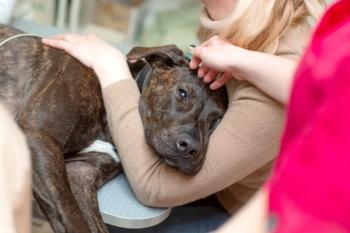
Live from CVC Kansas City: The 5 most common causes of chronic vaginitis
Investigate these common causes when you have an affected patient.
As part of their presentation "Reproductive disorders in neutered dogs and cats: Theriogenology for veterinarians who don't want to do theriogenology" on Friday, Aug. 23, at the CVC in Kansas City, Dr. Autumn Davidson and Tomas Baker addressed chronic vaginitis, a common urogenital condition seen in female dogs that have undergone an ovariectomy.
Chronic vaginitis often develops for multiple reasons, and the primary cause is often masked and exacerbated by previous therapies such as long-term antimicrobial therapy, self mutilation, and topical irrigations. Vaginal mucosal biopsy frequently shows nonspecific lymphocytic-plasmacytic inflammation, but sometimes suppurative (neutrophilic) or eosinophilic inflammation is predominant. Primary bacterial vaginitis is rare. Vaginal cultures can show overgrowth of an atypical bacterial species (pure gram-negative cultures, resistant organisms, Pseudomonas species) or pure culture of Mycoplasma species if antibiotics have been used extensively. Occasionally, a yeast overgrowth is identified.
In your affected patients, consider these five causes, which Dr. Davidson and Baker have noted most commonly at the University of California-Davis School of Veterinary Medicine:
- Extensive perivulvar dermatitis associated with redundant dorsal and lateral vulvar folds
- A granulomatous uterine stump (note: be sure to rule out stump pyometra)
- Vaginal foreign bodies such as foxtails or bone fragments
- Chronic urinary tract infection with urethritis, vestibulitis, or vulvitis
- Cystic, urethral, vaginal, or vestibular neoplasia
Dr. Davidson and Baker say they also often see vaginal strictures, but they are not usually causal. Most cases are idiopathic.
Newsletter
From exam room tips to practice management insights, get trusted veterinary news delivered straight to your inbox—subscribe to dvm360.




